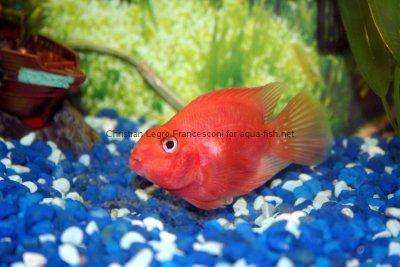Blood parrot cichlid
Scientific name: Blood parrot cichlid
Common name: N/A
Family: N/A
Usual size in fish tanks: 17 - 20 cm (6.69 - 7.87 inch)
014
Recommended pH range: 6.4 - 7
Recommended water hardness: 3 - 16°N (53.57 - 285.71ppm)
0°C 32°F30°C 86°F
Recommended temperature range: 23 - 28 °C (73.4 - 82.4°F)
The way how these fish reproduce: Spawning
Where the species comes from: Cultivated form / Hybrid
Temperament to its own species: peaceful
Temperament toward other fish species: peaceful
Usual place in the tank: Middle levels
Food and Feeding
Blood Parrot Cichlids are omnivores but require a carefully chosen diet due to their anatomical deformities—most notably their small, non-closing mouths. They eat by crushing food with throat muscles. Offer soft sinking pellets, gel foods, high-quality flakes, and frozen treats such as bloodworms and brine shrimp. Avoid hard or large foods to prevent choking.
Origin
The Blood Parrot Cichlid is a man-made hybrid fish, first developed in Taiwan in the late 1980s. Its exact lineage is debated, but likely parent species include Amphilophus citrinellus (Midas Cichlid), Heros severus (Severum), and other Central American cichlids. These fish do not exist in the wild.
Sexing
Sexing Blood Parrot Cichlids is extremely difficult. There are no reliable visual cues, and even experienced breeders often cannot distinguish males from females.
Breeding
Most males are sterile, which makes breeding difficult. However, females may still lay eggs, usually on flat surfaces like rocks. In rare successful cases, crossbreeding with other cichlids (e.g. Convicts or Severums) may produce viable offspring. In most cases, the eggs will be infertile, develop fungus, or be eaten.
Lifespan
With proper care, Blood Parrot Cichlids can live up to 10–15 years. Some specimens have been reported to live even longer in well-maintained aquariums.
Temperament and Behavior
Despite their fierce appearance, Blood Parrot Cichlids are peaceful and shy. They can be kept alone or in groups, and they usually become more confident over time. Tank mates should be peaceful to semi-aggressive cichlids of similar size. Avoid fin-nipping or highly aggressive species.
Tank Requirements
Due to their adult size (up to 20 cm), a minimum of 55 gallons (208 liters) is recommended. Use soft substrate to protect their mouths, and provide caves, plants, and rocks to create territories and reduce stress. A strong filtration system is essential due to their messy eating habits and high waste output. Perform weekly water changes of 25–30%.
Water Conditions
- Temperature: 23–28 °C (73.4–82.4 °F)
- pH: 6.4–7.0
- Hardness: 3–16°dGH
They prefer stable, clean water and benefit from moderate water flow.
Short Description
Blood Parrot Cichlids are colorful, hybrid cichlids created through selective breeding. They are known for their beak-shaped mouths, deep orange coloration, and unique personality. Although controversial due to their physical deformities, they remain popular among aquarists for their beauty and behavior when kept in well-maintained aquariums.
Pictures
Contributed by Christian Legro Francesconi.










 Flowerhorn
Flowerhorn